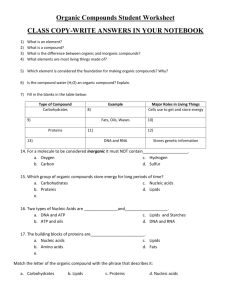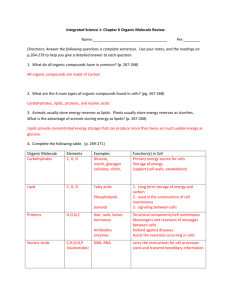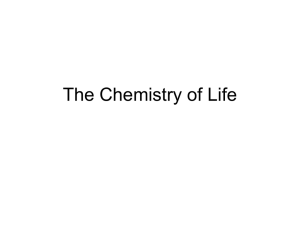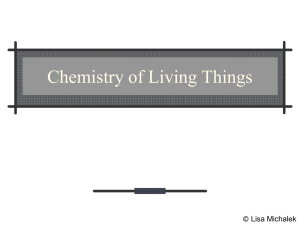Ch8 sec4Life with Carbon
advertisement
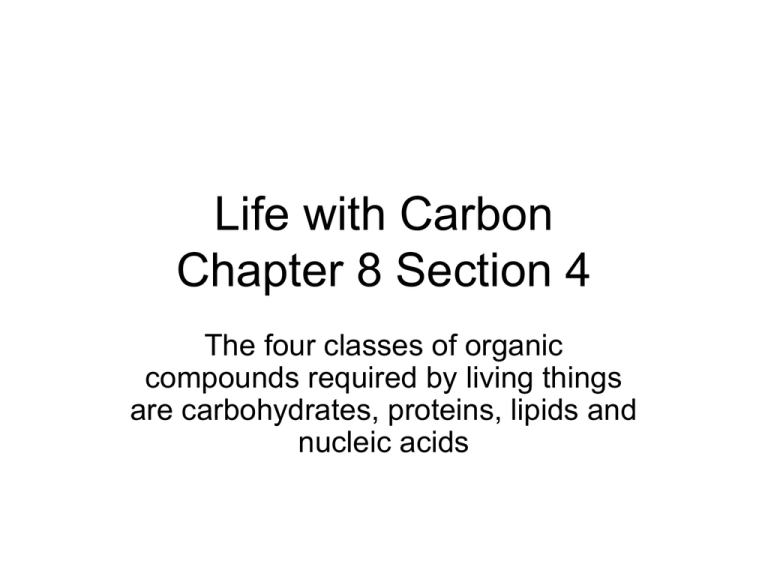
Life with Carbon Chapter 8 Section 4 The four classes of organic compounds required by living things are carbohydrates, proteins, lipids and nucleic acids Carbohydrates • Carbohydrate is an energy-rich organic compound made of the element carbon, hydrogen, and oxygen. • Types of Carbohydrates 1. Simple Carbohydrate Example simple sugar, glucose. 2. Complex Carbohydrate, Many simple carbohydrates bonded to one another. Example Starch and cellulose. Carbohydrates (Cont..) • Starch is found in bread, cereal, pasta, rice and potatoes. The energy released by breaking down starch allows the body to carry out its life functions. • Cellulose (Fiber) is found in plants, we cannot digest cellulose, however cellulose helps keep our digestive system healthy. Proteins • Our muscles, hair, skin and fingernails are all made of proteins. Hormones, Insulin & hemoglobin is Protein. – Chains of amino Acids Proteins are long chains of amino acids. Different proteins are made up of different sequence of amino acids. – Food Proteins Become your Proteins: Proteins are found in meat, fish, eggs, and milk products. The body uses proteins from food to build and repair body parts and to regulate cell activities. Lipids • Lipids are energy-rich compounds made up of carbon, oxygen and hydrogen. Lipids release twice as much energy in your body as do carbohydrates. – Fats and oils are made up of three fatty acids and one alcohol, glycerol. – Cholesterol is a waxy substance found in all animal cells. The body needs cholesterol to build cell structure and to form compound that serve as chemical messengers. Lipids (Cont..) • Lipids do not dissolve in water • Lipids make cell membrane • Lipids are used to store vitamins in the body • Lipids make up structure called a cell membrane that surrounds each cell. • Phospholipids that are found in the cell membrane help control the movement of the substances in and out of the cell. Nucleic Acids • Nucleic acids are very large organic molecules made up of carbon, oxygen, hydrogen, nitrogen, and phosphorous. The two types of nucleic acids are DNA and RNA. – Nucleotides are the building blocks of Nucleic acids. There are only four kinds of Nucleotides. – DNA and Proteins: The difference among living things depend on the order of nucleotides Nucleic Acids (Cont..) • When living things reproduce, they pass DNA and the information it carries to the next generation. • Nucleic acids are stored information • When a cell needs to make a certain protein it gets information from DNA in the cell. Other Nutrients • Organisms require water, vitamin, minerals and salts to support the function of large molecules. – Water Most of your body is made up of water, many chemical reactions take place in water, wastes from cells are dissolved in water and are carried out of the body. – Vitamins are organic compounds that serve as helper molecules in a variety of chemical reactions in your body. Other Nutrients (Cont..) - Minerals are not organic compounds they are ions needed in the body. - Salts Are ionic compounds found in your body as dissolved ion. Most important salt in our body is NaCl. Other salts help to keep blood pH balanced and also help for healthy teeth and bones.
